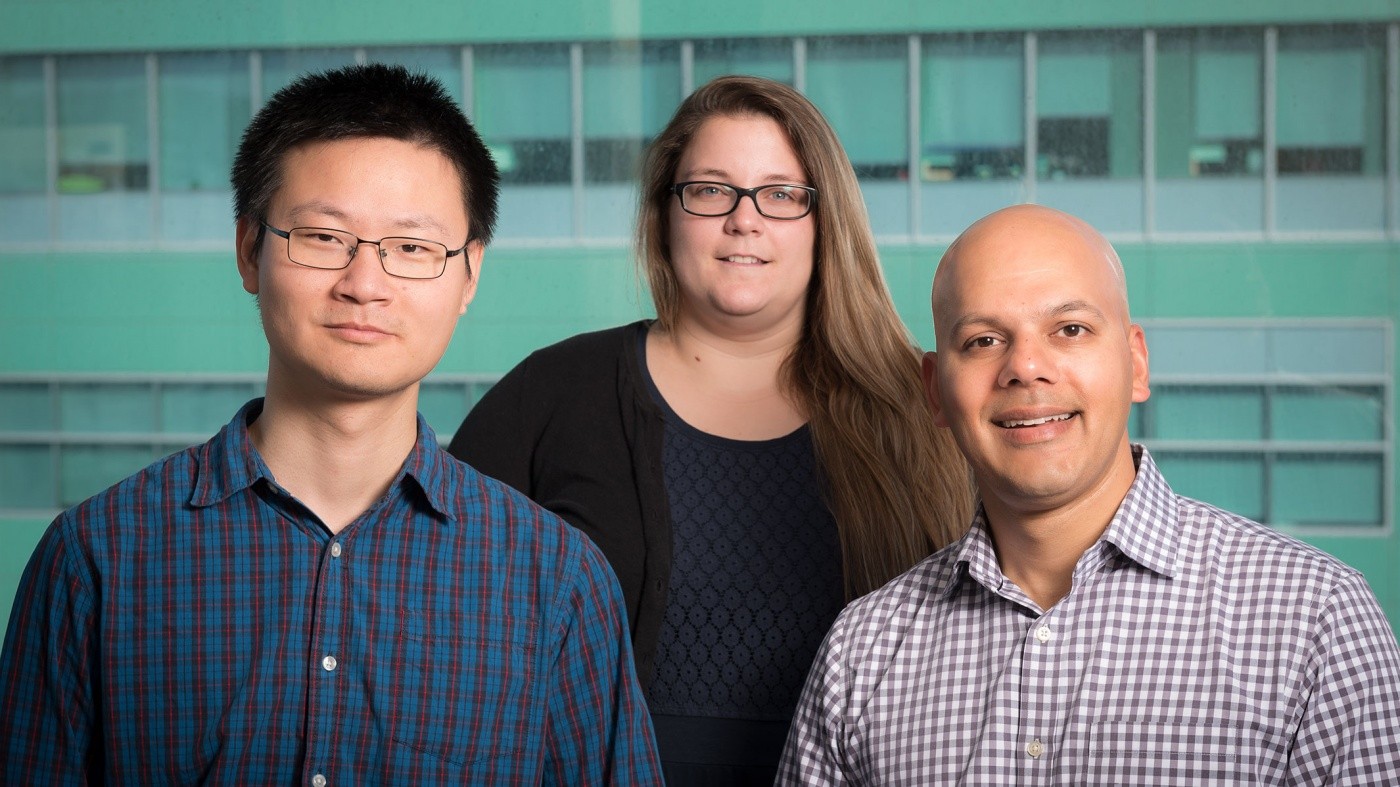Gladstone NOW: The Campaign Join Us on the Journey✕

Saptarsi Haldar (right), Qiming Duan (left) and Sarah McMahon (center) find a new strategy to treat heart failure. [Photo: Chris Goodfellow, Gladstone Institutes]
A team of researchers at the Gladstone Institutes uncovered a new strategy to treat heart failure, a leading contributor to mortality and healthcare costs in the United States. Despite widespread use of currently-approved drugs, approximately 40% of patients with heart failure die within 5 years of their initial diagnosis.
“The current standard of care is clearly not sufficient, which highlights the urgent need for new therapeutic approaches,” said Saptarsi Haldar, MD, an associate investigator at Gladstone and senior author of a new study featured on the cover of the scientific journal Science Translational Medicine. “In our previous work, we found that a drug-like small molecule called JQ1 can prevent the development of heart failure in mouse models when administered at the very onset of the disease. However, as the majority of patients requiring treatment already have longstanding cardiac dysfunction, we needed to determine if our strategy could also treat established heart failure.”
As part of an emerging treatment strategy, drugs derived from JQ1 are currently under study in early-phase human cancer trials. These drugs act by inhibiting a protein called BRD4, a member of a family of proteins called BET bromodomains, which directly influences heart failure. With this study, the scientists found that JQ1 can effectively treat severe, pre-established heart failure in both small animal and human cell models by blocking inflammation and fibrosis (scarring of the heart tissue).
“It has long been known that inflammation and fibrosis are key conspirators in the development of heart failure, but targeting these processes with drugs has remained a significant challenge,” added Haldar, who is also a practicing cardiologist and an associate professor in the Department of Medicine at the University of California, San Francisco. “By inhibiting the function of the protein BRD4, an approach that simultaneously blocks both of these processes, we are using a new and different strategy altogether to tackle the problem.”
Currently available drugs used for heart failure work at the surface of heart cells. In contrast, Haldar’s approach goes to the root of the problem and blocks destructive processes in the cell’s command center, or nucleus.
“We treated mouse models of heart failure with JQ1, similarly to how patients would be treated in a clinic,” said Qiming Duan, MD, PhD, postdoctoral scholar in Haldar’s lab and co-first author of the study. “We showed that this approach effectively treats pre-established heart failure that occurs both after a massive heart attack or in response to persistent high blood pressure (mechanical overload), suggesting it could be used to treat a wide array of patients.”
Using Gladstone’s unique expertise, the scientists then used induced pluripotent stem cells (iPSCs), generated from adult human skin cells, to create a type of beating heart cell known as cardiomyocytes.
“After testing the drug in mice, we wanted to check whether JQ1 would have the same effect in humans,” explained co-first author Sarah McMahon, a UCSF graduate student in Haldar’s lab. “We tested the drug on human cardiomyocytes, as they are cells that not only beat, but can also trigger the processes of inflammation and fibrosis, which in turn make heart failure progressively worse. Similar to our animal studies, we found that JQ1 was also effective in human heart cells, reaffirming the clinical relevance of our results.”
The study also showed that, in contrast to several cancer drugs that have been documented to cause cardiac toxicity, BRD4 inhibitors may be a class of anti-cancer therapeutics that has protective effects in the human heart.
“Our study demonstrates a new therapeutic approach to successfully target inflammation and fibrosis, representing a major advance in the field,” concluded Haldar. “We also believe our current work has important near-term translational impact in human heart failure. Given that drugs derived from JQ1 are already being tested in cancer clinical trials, their safety and efficacy in humans are already being defined. This key information could accelerate the development of a new heart failure drug and make it available to patients more quickly.”
This project was conducted in collaboration with Deepak Srivastava, MD, director of the Gladstone Institute of Cardiovascular Disease. Other Gladstone scientists on the study include Priti Anand, Sean Thomas, Hazel T. Salunga, and Yu Huang. Collaborators from Case Western Reserve University, Plantagenet, Vanderbilt University, Dana-Farber Cancer Institute, and University of Colorado Denver also took part in the study. Research at Gladstone was supported by the National Institutes of Health (grants DK093821 and HL127240).
Meet Gladstone: Saptarsi Haldar
Meet Gladstone: Saptarsi Haldar
Saptarsi chats about the growth of his lab over the past 2 years, his love of soccer, and his hidden musical talents.
Profile Haldar LabProfile: Sarah McMahon
Profile: Sarah McMahon
Sarah shares how summers spent by the ocean piqued her interest in science.
Haldar LabHealing Hearts across the Lifespan
Healing Hearts across the Lifespan
A trio of Gladstone scientists are studying the basic biology of the heart to guide the discovery of new therapies for conditions such as congenital heart disease and heart failure.
Heart Failure Congenital Heart Disease Bruneau Lab Haldar Lab Srivastava Lab Basic Science



